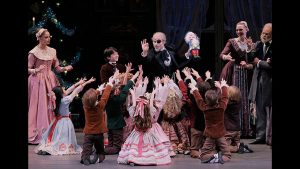 Come joins us at the library at 2:30 pm to watch this Lincoln Center recording of the Nutcracker ballet.
Come joins us at the library at 2:30 pm to watch this Lincoln Center recording of the Nutcracker ballet.
The Nutcracker first premiered on December 17, 1892, at the Mariinsky Theatre in St. Petersburg, Russia. At its premiere, The Nutcracker was considered a failure by the public and critics. Tschaikovsky died less than a year later, not knowing what a huge international success the ballet would later become.
Here are some fun facts on New York City Ballet’s production of George Balanchine’s The Nutcracker™:
- the giant Christmas tree grows to a full height of 41 feet and weighs 1 ton
- 57 people work backstage to coordinate the scenery, lighting, and costumes during each performance
- 62 musicians play in the orchestra for each performance
- 150 costumes appear onstage in each performance of George Balanchine’s The Nutcracker™. The only costumes still in use from the original 1954 production of George Balanchine’s The Nutcracker™ are the Grandmother’s cape and the embroidered appliqués on the women’s costumes in the Tea dance
- the music for the violin solo during the change of scenery in Act I is actually taken from Tschaikovsky’s score for the ballet The Sleeping Beauty
- the Sugarplum Fairy’s tutu is made of 7 layers of tulle
- between 600 and 700 lighting instruments are used in the stage lighting for the production
- Tschaikovsky based the music for the Coffee dance on the melody of a Georgian lullaby
- the bodices of the dresses worn by the women in the Hot Chocolate dance are decorated with small cameo pictures of New York City Ballet Founders Lincoln Kirstein (on the soloists) and George Balanchine (on the corps de ballet dancers)
- there are 144 jingle bells on each of the Candy Cane costumes
- Mother Ginger’s skirt is supported by a 40-pound metal frame
- most of the scenery in the production is actually painted fabric
- the Dewdrop costume is adorned with 65 crystal dewdrops
- the special instrument played for the Sugarplum Fairy’s solo is a celesta. Tschaikovsky used the newly-invented celesta to make the music for the Sugarplum Fairy sound like the “sprays of a fountain” as the choreographer Marius Petipa requested